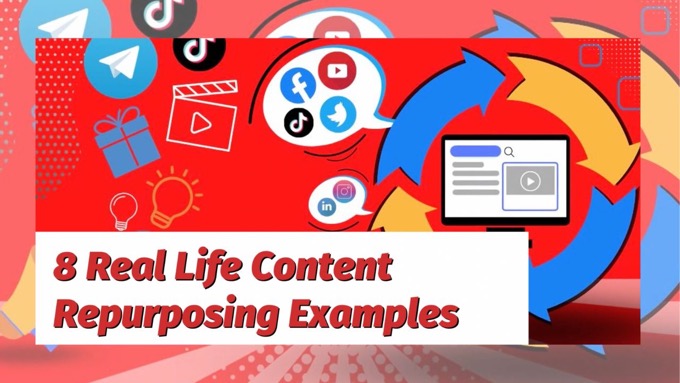What if you could have a steady stream of content produced for social media that kept your social profiles alive and interesting?
Knowing how to repurpose content for social media effectively is essential.
This post gives you a 5-part framework for doing just that!
In fact, it’s probably the most efficient way to repurpose content for social media currently available.
But first…
Why Is Repurposing Content for Social Media Important?
Unless you’re regularly repurposing content for social media, you’ll find it an uphill battle to keep your social media profiles full of enough content to keep them fresh and interesting.
By repurposing content systematically, you can keep your social profiles alive with a steady flow of new content without ever running out of ideas.Click To Post OnNot only that, but creating content for social without any repurposing is horribly inefficient, and will be far harder and time-consuming than it needs to be.
Instead, creating new social posts by repurposing content you have elsewhere means that you:
- Are able to fill your profiles with a lot more content — and on many social platforms, visibility is a volume game
- Save a ton of time that you can allocate to other things
- Are increasing your ROI from the original content you’re repurposing from
- Can keep your messaging and content more consistent across different channels, helping to establish a clearer brand identity
- Are able to show up on social media more regularly and consistently
5-Part Framework: The Most Efficient Way to Repurpose Content for Social Media
Most approach repurposing content for social media sporadically.
That means there’s no system, so it doesn’t get done regularly or consistently, and a lot of the value of their hard-earned content that’s published elsewhere is simply lost.
Most businesses approach repurposing content for social media sporadically. There's no system, there's no consistency, and the inherent value in their existing content is wasted.Click To Post OnThe good news is that there is a better way.
Here’s a 5-part framework that, put into action, gives you what is likely to be the most efficient (and also effective) way to repurpose content for social media…
1. Start With Your Pillar Content Channel
You should have one content channel where you’re regularly publishing new and original content on a consistent basis.
This is your pillar content channel.
Common pillar content channels include:
- A blog
- A YouTube channel
- A podcast
A blog is ideal, presuming it exists on your own website, because it’s in an environment you fully control, and no one (for the most part) can shut you down.
If your pillar content channel resides on a third-party platform, there’s always a risk your account could be shut down, often with zero notice. That means you can lose everything, overnight, at the whim of a salaried exec.
Either way, for your pillar content channel, you just need to be publishing regularly, ideally once per week minimum.
2. Choose ONE Repurposing Method and ONE Channel
The second step is to choose just:
- If your pillar content channel is a B2B YouTube channel, you might decide to:
- Repurpose that by creating text-based content, such as taking a transcript of the video and turning that into a readable article (or if suitable, simply leaving the transcript as-is)
- Publishing that on Medium or LinkedIn articles (likely with the original video embedded somewhere).
- If your pillar content channel is a blog, you might decide to repurpose it into a set of carousel images to publish on Instagram.
if you need some ideas about the types of repurposing methods available, here’s a quick video with 21 different ways to repurpose content for social media (or see the full article here):
Why pick just ONE repurposing method and just ONE channel?
The first time you do this, it’s about setting some early habits and consistency. Attempting too much too soon, and it’s likely it simply won’t happen consistently, defeating the whole purpose of the exercise.
We’ll get to how to build this up further in a later step.
3. Systematize It
Third, you now create the process that needs to be followed in order to achieve your desired goal (as decided in Step #2 above).
It’s not a case of reinventing the wheel each time. It’s about defining an easy-to-follow process that can be:
- Delegated to one or more people, whether immediately or at some point in the future
- Optimized over time as you find ways to tweak and improve what you do.
Let’s say that in Step #2, you decided to repurpose each post you publish on your blog in future as an article for LinkedIn.
So what process would you need to accomplish that?
First, decide on the individual components—or content assets—you’ll need.
Here are a couple examples so you can see how it works:
- To repurpose as a LinkedIn article, you’ll need two such content assets, namely:
- A 1280 x 720px cover image. This is what’s shown at the top of the article when people read it, and is also used as part of the preview when the article’s shared via social media posts. The image could be adapted from the featured image used on your original blog post, or created from scratch using a tool like Canva.
- A rewrite of the original post. By rewriting it rather than using the original, you: (a) attract additional traffic from search engines; and (b) keep the content on your own blog unique so you maximize its authority and potential organic traffic levels, rather than sacrificing that for the benefit of third-party sites you don’t control. And you can now use AI tools to help!
- To repurpose as an Instagram carousel, you'll need:
- A 100 to 150 word ‘script’ that summarizes the main points of the original post, to be used as the text on the different images. Once done, that can be used for…
- A set of related images to be used for the carousel.
Makes sense?
Once you’ve decided on the individual content assets, you need to determine:
- Who’s going to create them (even if that’s just you at the beginning). For example, creating written content and creating graphic content are two very different skill sets. It’s unlikely that someone good at creating one will be the best person to create the other. So make a note of who’s doing what.
- If there’s a sequential order in which the content assets should be created:
- For our LinkedIn article example above, both the image and the rewrite could be created in tandem.
- For our Instagram carousel example, the script needs to be created before the images.
Got all the info you need?
Now sketch out a rough flow chart—the back of an envelope is fine for now! You can always formalize it if you want to later on.
All you need is simply to be able to see:
- What the process looks like visually
- If there are any holes or hiccups in the process that need to be addressed in order to achieve your goal.
Roughly circled text with arrows pointing to the next bit(s) in the process are all you need—but don’t get hung up on it, just do whatever works for you.
4. Master It
By now, you’ve decided:
- One way in which you want to repurpose content from your pillar content channel each time you publish
- Which social media channel you want to post that on
- The process you need to achieve that, including the content assets required and who will have responsibility for creating them
The next step is to simply master the process by following it on a consistent basis, and refining it each time.
The easiest way to achieve consistency is to make someone else on your team explicitly responsible for following or overseeing the process each time.
If for some reason it’s still not done consistently, then examine what the obstacles are and look for creative ways to overcome them.
For example, you might need to:
- Assign someone else to the role
- Provide the appropriate training, mentoring or other support
- Tweak the process to make it easier to achieve, or a better fit for the person’s skills
- Adjust the person’s other responsibilities so they have enough time to allocate to it
As for the process itself, mastery involves:
- Looking for ways to optimize it and make it more efficient
- Improving the end result
You might realize over time that the type of content you’re creating perhaps isn’t as engaging as it might be for the social platform you’re posting it on.
So you look for ways to tweak and improve it in future, and adjust your process accordingly.
Once you’ve optimized the repurposing process and it’s well ingrained in your business to the extent that it’s being followed on a fully consistent basis, you’re ready for the next step, namely…
5. Rinse and Repeat #2 to #5
Finally, you keep repeating Steps #2 and onwards, layering additional ways to repurpose content for social media into your business.
As you do so, you’ll see that over time you create additional ways to re-use content assets you’re already creating as part of another process.
- Images created for a carousel on Instagram could be used for a similar carousel on LinkedIn
- A blog post rewritten for LinkedIn articles could be cross-posted to Medium
It means that additional processes can be added with little extra time and effort.
What you’re aiming for is to have, over time, multiple processes that kick off each time you publish content on your pillar content channel, repurposing that content for social media in a regular and consistent manner.
By having clear processes and different people responsible for the different moving parts of those processes, you’ve effectively created a well-oiled machine that’s consistently repurposing content for social media channels, bringing your presence on those platforms to life with a constant supply of new content that you don’t have to really think about.
Instead, you just know it’s taken care of each and every time a new piece of content is published through your pillar content channel.
The only issue is, as the number of processes you have in place starts to grow, how to manage this repurposing “machine” effectively so that the cogs can keep turning.
That’s what we’re looking at next…
Master the Repurposing Game
You’ll find that as you add more processes into your content repurposing workflow, it rapidly becomes more challenging to master and keep on top of everything that’s happening for each piece of content.
This is when things can rapidly start to fall apart and you find yourself back at square one… or you start using some suitable software to help.
It’s a little like trying to run an email list without an autoresponder service. After the first few subscribers, you’d rapidly find it became impossible to keep track of which subscriber is due to receive which message and when.
Trying to take care of it manually is of course grossly inefficient, involving a big waste of time and energy, as well as likely introducing mistakes in the “process” — and that’s where software steps into help.
The same applies to content repurposing.
It’s probably fine without software if you’re just skimming around the edges and not doing very much.
But once you’re ready to get serious and want to see some proper results from repurposing, you need to be able to scale up your activities, and that’s where the appropriate workflow together with the right software becomes vital.
Trafficonomy is built-for-purpose software that means you can essentially publish once but then distribute everywhere.
Appropriate tasks are triggered and assigned to appropriate members of your team whenever you publish something new through your pillar content channel, allowing you to:
- Keep track of everything that’s happening
- Monitor the content assets that are produced
- Achieve your content repurposing goals, whether for social media or elsewhere, far more easily and efficiently
Frequently Asked Questions
Why is repurposing content for social media important?
Repurposing content systematically keeps social profiles fresh with new content and optimizes time and ROI.
How can I start repurposing content for social media efficiently?
Start by selecting one repurposing method and one social media channel, and establish a consistent process.
What is the importance of systematizing content repurposing?
Systematizing the process ensures efficiency, delegation, and optimization for consistent results.
How can I master the content repurposing process?
Master the process by following it consistently, assigning responsibilities, and continuously optimizing for better results.
How can I effectively manage multiple content repurposing processes?
Expand by adding more repurposing methods while maintaining clear processes and responsible team members for each, creating a consistent content flow.
To Conclude
So you now have a highly efficient and effective way to repurpose content for social media on a regular and consistent basis, growing your social media presence in a way that’s just “taken care of” and growing your return on investment from the creation of the original content.
Putting this into practice puts you head and shoulders above the vast majority of small businesses who approach social media in a far more sporadic fashion with no real “system” to speak of.
Finally, if you’re already posting content to social media that you find to be effective, continue doing that, but use the above framework to scale up your social media output.




